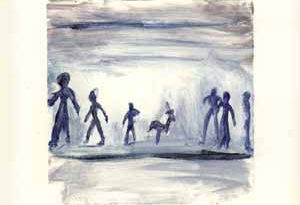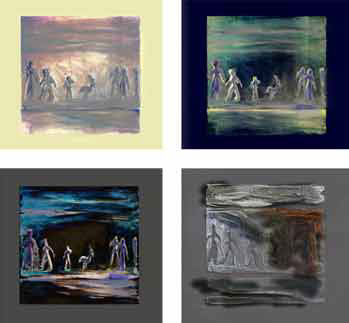Creative Thinking in Photoshop: Art from the Ashes

Welcome to Creative Thinking — the new creativepro.com column dedicated to the nonlinear way digital artists really work. As author of “The Illustrator Wow! Books” I appreciate the value of following exacting software recipes to replicate specific effects, but as an artist I’m also keenly aware that we rarely create by simply following a linear string of instructions. Therefore, Creative Thinking will focus more on concepts for being creative and on ways of working — from digital brainstorming, improvising, and experimenting to integrating digital and traditional tools.
While you’ll still get your fill of specific tips and techniques from most of these articles, I hope you’ll also be open to how a new approach or way of working might enhance your creative process and expand your creative potential. I’ll often have to impose linear constraints on what I’m describing (so you’ll be able to follow the narrative), but remember that the actual creative process was likely to have been more meandering and improvisational.
Inspiration
As this introductory Creative Thinking column coincides with the first anniversary of the September 11 attacks, I am compelled to focus on the image that I created in response to the World Trade Center (WTC) disaster, “From the Ashes, September 2001” (see figure 1). In a completely unplanned and nonlinear way, I used Photoshop’s Layers, Layer Masks, and Layer Sets to weave new elements into an existing image. Despite the fact that this image evolved improvisationally, you can use variations of this process to insert elements into any existing image.
 Figure 1: “From the Ashes, September 2001”
Figure 1: “From the Ashes, September 2001”The Process
Many things that are impossible within the traditional worlds of art and photography can be magically realized in Photoshop. In this project I rely on the stacking order of Photoshop’s layers to control what elements lie on top of others, and then use duplicates of layers and Layer Masks to create the illusion of inserting new elements into an existing image.
To accomplish this illusion of weaving new elements within (not just on top of) an existing composition, I use the Layers palette to sandwich the layers containing the new elements between the original image layer and a duplicate of the original. With the original image as the bottom (background) layer, the new elements exist on layers above the background.
To complete the illusion, a duplicate of the original image resides on top (above the new elements). To control which portions will be seen above the new elements (thus forming the foreground) this duplicate gets a Layer Mask. This project also will demonstrate how I was able to create new layers, move and scale my elements, and even group layers together in Layer Sets, all while maintaining the illusion of items being in front or behind others.
The Project
In the first weeks after 9-11, like most Americans, I was incapable of being useful, much less creative. My brother and his fiancé lived just blocks from the WTC site, so much of that immediate time was spent trying to establish and maintain communications with them, and to attempt to stop crying long enough to get anything done at all. When finally I was able to get back to work, I decided that I’d start out by organizing a series of digital images that I’d created in the months previous.
I’d begun these images using a traditional printmaking process called monotype (see figure 2). I then scanned the monotype prints in Photoshop, and reworked them using Photoshop’s blending modes and adjustment layers (see figure 3). Methodically opening up each image in turn, I was merely trying to decide which ones I was going to be using for my current project.
 Figure 2: One of the original monotypes
Figure 2: One of the original monotypes Figure 3: Variations on the monotypes using blending modes and adjustment layers in Photoshop
Figure 3: Variations on the monotypes using blending modes and adjustment layers in PhotoshopThen something about one particular version made me stop (see figure 4). In the new post-9-11 context, this hazy dark version screamed to me of the video and photographic images I’d seen of people moving amongst the ashes of the collapsed World Trade Center. I decided to table my organization effort and focus on reworking this image.
 Figure 4: The variation that inspired the image
Figure 4: The variation that inspired the imageThis article was last modified on January 3, 2023
This article was first published on September 10, 2002




As a programmer I often have difficulties to express my ideas on an inspirational manner. That is why I consider this article very useful and interesting. I wish you will post more articles like this one.